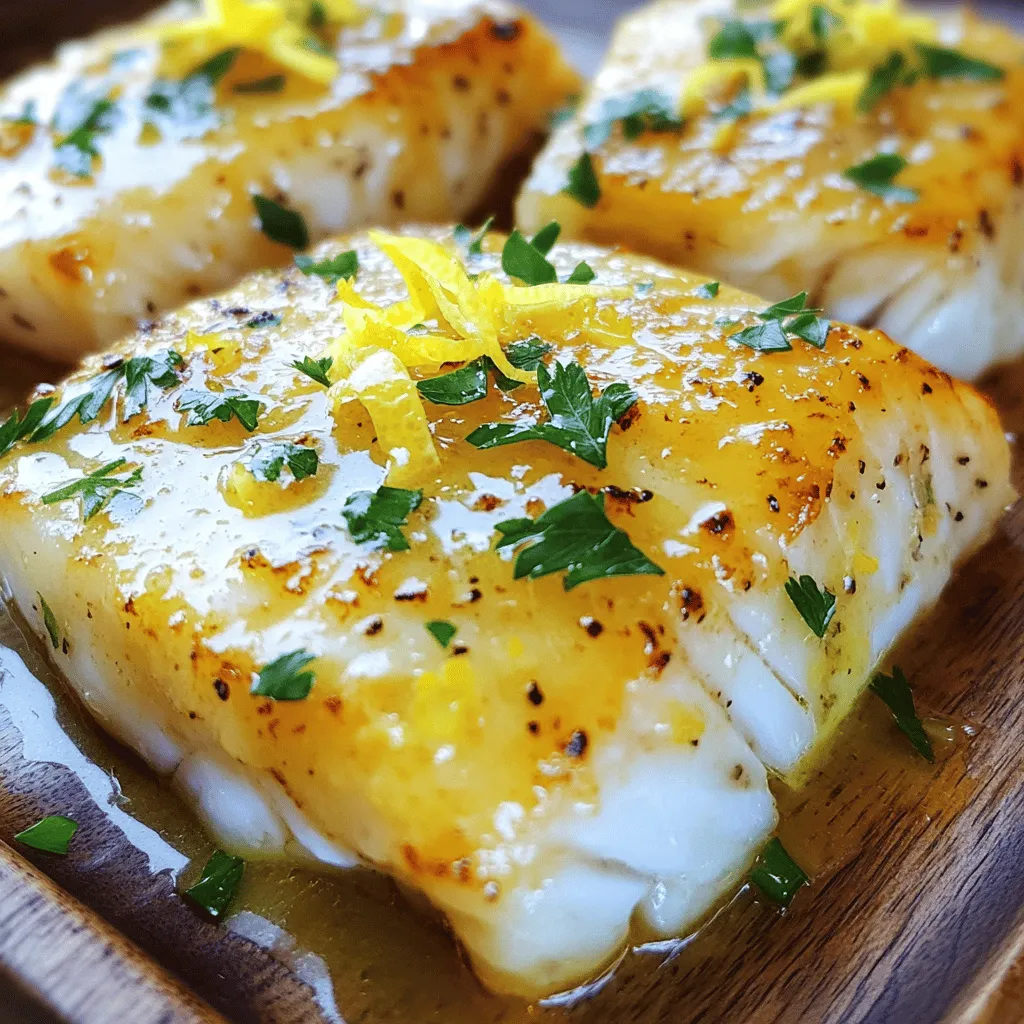Introduction
Cod is one of the most beloved fish varieties around the world, celebrated for its mild flavor, flaky texture, and versatility in the kitchen. Whether baked, grilled, or sautéed, cod adapts beautifully to a variety of culinary styles, making it a favorite among home cooks and professional chefs alike. One of the most delightful ways to prepare this fish is by pan-searing it in a rich lemon butter sauce. This recipe not only elevates the cod’s natural flavors but also introduces a refreshing citrus note that brightens the dish.
The concept of lemon butter sauce is a culinary classic that adds a luxurious touch to any meal. The combination of creamy butter and tangy lemon creates a sauce that is both rich and refreshing, making it an ideal partner for the delicate flavors of cod. This dish is not only simple to prepare but also quick, allowing for a delicious meal on even the busiest weeknights. With just a few ingredients and minimal cooking time, you can impress your family or guests with a restaurant-quality dish right in your own kitchen.
In addition to its exquisite taste, cod is also a nutritious option that fits perfectly into a balanced diet. It is low in calories and fat while being rich in protein, making it a heart-healthy choice. Cod is also an excellent source of essential nutrients, including omega-3 fatty acids, vitamin B12, and selenium, which contribute to overall health and wellness. Incorporating cod into your meals not only satisfies your taste buds but also supports your nutritional needs.
Understanding Cod as a Culinary Ingredient
Overview of Cod: Types and Nutritional Benefits
Cod belongs to the family Gadidae and is primarily found in the North Atlantic Ocean. There are several types of cod, with Atlantic cod and Pacific cod being the most common varieties. Atlantic cod is known for its slightly sweeter flavor and firmer texture, while Pacific cod has a milder taste and is often favored for its flaky, tender meat. Both types of cod are versatile and can be used interchangeably in many recipes.
From a nutritional standpoint, cod is a powerhouse. A 3-ounce serving of cooked cod contains approximately 70-90 calories, depending on the cooking method, and provides around 20 grams of protein. Its low-fat content makes it an ideal choice for those looking to maintain a healthy weight without sacrificing flavor. Additionally, cod is rich in essential vitamins and minerals, making it a smart addition to any diet.
The Significance of Freshness in Selecting Cod Fillets
When preparing cod, freshness is paramount. Fresh cod fillets should have a clean, ocean-like smell and a firm, moist texture. The flesh should be translucent and free of any discoloration or brown spots. If purchasing whole fish, look for bright, clear eyes and vibrant skin. For the best flavor and texture, it’s advisable to buy cod from a reputable fish market or grocery store that prioritizes quality and sustainability.
Cooking Methods Suitable for Cod: Baking, Grilling, and Sautéing
Cod is incredibly versatile and can be prepared using various cooking methods. Baking is a popular choice, allowing the fish to cook evenly while retaining moisture. Grilling imparts a smoky flavor, enhancing the fish’s natural sweetness. However, one of the most effective methods for achieving a crispy exterior and tender interior is sautéing. This technique allows for quick cooking at high heat, making it perfect for weeknight dinners like our lemon butter sautéed cod.
Flavor Profiles That Complement Cod: Focusing on Citrus and Herbs
Cod’s mild flavor makes it an excellent canvas for a wide range of seasonings and ingredients. Citrus fruits, particularly lemon, pair beautifully with cod, enhancing its natural flavors without overwhelming them. Fresh herbs, such as parsley, thyme, and dill, are also great companions, adding depth and complexity to the dish. The combination of lemon and herbs not only brightens the flavor but also creates a visually appealing presentation.
Ingredients Breakdown for Lemon Butter Sautéed Cod
Detailed Description of Each Ingredient and Its Role in the Recipe
To prepare a delicious lemon butter sautéed cod, you will need the following ingredients:
Cod Fillets
The star of the dish, cod fillets provide a flaky texture and mild flavor that pairs perfectly with the rich lemon butter sauce. When selecting your fillets, ensure they are fresh and of high quality.
Butter
Quality butter is crucial for this recipe, as it forms the base of the sauce. It adds richness and depth of flavor, making the dish indulgent yet balanced. Opt for unsalted butter to control the saltiness of the dish.
Olive Oil
Using olive oil along with butter helps prevent the butter from burning, allowing for a perfect sauté. It also adds a layer of flavor that complements the cod beautifully.
Garlic
Fresh garlic is a must-have ingredient that enhances the dish’s flavor profile. Its aromatic qualities infuse the butter sauce, adding a savory depth that pairs well with the cod and lemon.
Lemon Zest and Juice
The brightness of lemon zest and juice is what elevates this dish to new heights. The zest provides a concentrated lemon flavor, while the juice adds acidity, balancing the richness of the butter.
Thyme
Fresh thyme adds an earthy, herbal note to the dish, enhancing the overall flavor without overpowering the delicate taste of the cod. Thyme also has a lovely aroma that complements the lemon.
Salt and Pepper
Seasoning with salt and pepper is essential to bring out the flavors of the ingredients. Adjust to taste, ensuring that the seasonings enhance rather than mask the natural flavors of the fish.
Fresh Parsley
Chopped fresh parsley is used for garnish, adding a pop of color and freshness to the dish. It also complements the lemon and herbs, enhancing the overall presentation.
The Importance of Quality Butter and Olive Oil
Using high-quality butter and olive oil can significantly impact the flavor of your dish. Butter adds a creamy richness, while olive oil contributes a fruity note. Together, they create a luscious sauce that envelops the cod fillets. Look for European-style butter for a higher fat content, which results in a creamier sauce, and choose a good quality extra virgin olive oil for the best flavor.
Discussing the Choice of Garlic and Its Flavor Enhancement Properties
Garlic is a staple in many cuisines and is known for its ability to enhance the flavor of dishes. In this recipe, fresh garlic is sautéed in the butter and olive oil mixture, releasing its aromatic qualities and infusing the sauce with a savory depth. Be sure to use fresh garlic cloves rather than powdered garlic to achieve the best results.
Exploring the Role of Lemon Zest and Juice in Brightening the Dish
Lemon zest is the outer peel of the lemon, packed with essential oils that provide intense flavor without the acidity of the juice. In this recipe, both the zest and juice are used to brighten the dish, adding a refreshing contrast to the rich butter. The acidity of the lemon juice cuts through the fat, creating a well-balanced sauce that complements the flaky cod.
The Function of Thyme in Adding Depth to the Flavor Profile
Thyme is an aromatic herb that adds a subtle earthiness to the dish. Its flavor is warm and slightly minty, which pairs beautifully with lemon and garlic. Fresh thyme is preferred for its vibrant flavor, but dried thyme can be used if fresh is unavailable. When adding thyme to the sauce, be careful not to overpower the dish; a little goes a long way.
Importance of Seasoning: Salt and Pepper to Taste
Proper seasoning is essential in cooking, as it enhances the natural flavors of the ingredients. Salt brings out the sweetness of the cod, while black pepper adds a touch of heat. Adjust the seasonings to your preference, but remember that you can always add more; it’s much harder to correct over-seasoning.
Garnishing with Parsley for Visual Appeal and Freshness
A sprinkle of freshly chopped parsley not only adds a vibrant touch of color but also provides a fresh, herbal note that complements the dish. Garnishing your lemon butter sautéed cod with parsley elevates the presentation and adds a final touch of flavor.
Step-by-Step Instructions for Preparing Lemon Butter Sautéed Cod
Preparation: Initial Steps to Ensure Perfect Fillets
Before diving into the cooking process, there are a few initial steps to ensure your lemon butter sautéed cod turns out perfectly:
1. Select Fresh Cod Fillets: Choose high-quality cod fillets that are firm and have a mild ocean scent. If possible, buy them on the same day you plan to cook for the freshest taste.
2. Pat the Fillets Dry: Use paper towels to pat the cod fillets dry. Removing excess moisture helps achieve a perfect sear, allowing the fish to develop a golden brown crust.
3. Season the Cod: Generously season both sides of the fillets with salt and pepper. This step is crucial for enhancing the flavor of the fish.
4. Prepare Your Ingredients: Measure out your ingredients and have them ready to go. This includes slicing the garlic, zesting the lemon, and chopping the parsley. Having everything prepped in advance makes the cooking process smoother and more enjoyable.
5. Heat Your Pan: Choose a large, heavy-bottomed skillet for even cooking. Place it over medium heat and allow it to warm up before adding the butter and olive oil mixture.
Following these preparation steps will set the stage for a successful cooking experience, ensuring your lemon butter sautéed cod is both delicious and visually appealing. The combination of fresh ingredients, careful seasoning, and proper cooking techniques will elevate this dish to a new level, making it a favorite at your dinner table.

Cooking Process: Searing Techniques for a Crispy Exterior
To achieve a perfectly cooked Lemon Butter Sautéed Cod, mastering the searing technique is crucial. Start by ensuring your skillet is adequately heated—this is where the magic happens. Preheat your skillet over medium-high heat for a few minutes before adding any oil. A hot pan helps create a crispy exterior while locking in moisture within the fish.
Use a high-smoke point oil, such as canola or avocado oil, which can withstand the heat without burning. Once the oil shimmers, carefully place the cod fillets into the skillet, ensuring they have enough space to avoid overcrowding. Overcrowding can lower the pan’s temperature and result in steaming rather than searing, which doesn’t yield that coveted golden crust.
Cook the fillets undisturbed for about 3-4 minutes, or until they easily release from the pan. Flip the fillets gently with a spatula, being careful not to break them apart. You should see a beautiful golden-brown color on the cooked side. Continue cooking for an additional 2-3 minutes, depending on the thickness of the fillets, until the fish is opaque and flakes easily with a fork. This searing process not only enhances the texture but also the overall flavor of the dish.
Importance of Temperature Control During Cooking for Optimal Results
Temperature control is a critical aspect of cooking fish, particularly when it comes to cod, which can easily overcook if not monitored closely. Cod is best cooked at medium to medium-high heat to ensure an even cook while maintaining moisture. If the temperature is too low, the fish will not brown properly, resulting in a pale appearance and lack of depth in flavor.
Additionally, using a meat thermometer can be a game-changer. The ideal internal temperature for cooked cod is 145°F (63°C). Investing in this simple kitchen tool can help you achieve consistent results, ensuring your cod is perfectly cooked every time. Remember that the fish will continue to cook slightly after being removed from the heat, so consider taking it off the skillet just before it reaches the target temperature.
Making the Lemon Butter Sauce: Techniques to Enhance Flavor
The lemon butter sauce is the star of this dish, and there are a few techniques to elevate its flavor profile. Start by melting unsalted butter in the same skillet used for the cod, scraping up any brown bits left in the pan. This adds a depth of flavor known as fond, which is essential for a rich sauce.
Next, incorporate minced garlic for a fragrant base, cooking it gently until fragrant but not browned. The addition of fresh lemon juice and zest is what brings brightness to the sauce; the acidity will balance the richness of the butter. For an extra dimension of flavor, consider adding a splash of white wine or vegetable broth to deglaze the pan, allowing it to reduce slightly before returning the cod to the skillet.
To finish, stir in fresh herbs such as parsley or dill for a touch of freshness. These herbs not only enhance the visual appeal of the dish but also provide a pleasant contrast to the buttery sauce. This technique ensures a well-rounded and flavorful sauce that beautifully coats the cod.
Combining the Elements: Returning Cod to the Skillet for Flavor Integration
Once your lemon butter sauce is ready, it’s time to bring the dish together. Gently return the seared cod fillets to the skillet, spooning the sauce over the top. This allows the fish to absorb the flavors of the sauce while warming through. Let the cod simmer in the sauce for an additional minute or so, ensuring it’s heated evenly and the flavors meld together.
This integration step is crucial as it allows the fish to soak up the zesty and buttery flavors, creating a harmonious dish. When plating, drizzle any remaining sauce over the cod for an appealing presentation, and sprinkle with additional fresh herbs for a pop of color.
Serving Suggestions That Elevate the Dining Experience
Serving Lemon Butter Sautéed Cod can be as simple or as elaborate as you desire. For a casual meal, serve the cod alongside steamed vegetables such as asparagus or green beans. These vegetables add a touch of color and a nutritious element to the plate. For a heartier option, consider pairing the dish with fluffy rice, quinoa, or a creamy risotto, which can soak up the delicious lemon butter sauce.
For a more refined dining experience, serve the cod on a bed of lightly dressed mixed greens or a vibrant salad featuring seasonal ingredients. This not only adds texture and freshness but also brightens the overall meal. A simple vinaigrette made with olive oil, balsamic vinegar, and a touch of honey can complement the flavors of the fish beautifully.
Nutritional Information and Health Benefits
When it comes to nutrition, cod is a powerhouse. This white fish is low in calories and high in protein, making it an excellent choice for health-conscious individuals. A 3-ounce serving of cooked cod contains approximately 70-90 calories, 20 grams of protein, and less than 1 gram of fat, depending on the cooking method. It is also a great source of essential nutrients such as vitamin B12, phosphorus, and selenium.
Incorporating fish into your diet has numerous health benefits. Fish is known for being rich in omega-3 fatty acids, which contribute to heart health, support brain function, and reduce inflammation. Additionally, the use of fresh ingredients in this recipe, such as lemons and herbs, provides vitamins and antioxidants that further enhance the dish’s health benefits.
For those monitoring their caloric intake, this dish can easily fit into various dietary plans, including low-carb, Mediterranean, and even some weight-loss programs. With its light yet satisfying profile, Lemon Butter Sautéed Cod is a delicious option for a healthy meal.
Pairing Suggestions for Lemon Butter Sautéed Cod
To complement the savory and bright flavors of Lemon Butter Sautéed Cod, consider pairing it with side dishes that provide contrast and balance. Roasted or sautéed seasonal vegetables, such as zucchini, bell peppers, or carrots, can provide a lovely crunch and additional nutrients. For a heartier side, a grain like wild rice or quinoa works beautifully, as it absorbs the flavors of the sauce.
When it comes to wine pairings, a crisp white wine such as Sauvignon Blanc or Pinot Grigio enhances the citrus notes of the dish. These wines have bright acidity that echoes the freshness of the lemon sauce, making for a well-rounded dining experience. If you prefer red wine, a light-bodied varietal such as Pinot Noir can also work, as long as it is served slightly chilled.
For an extra touch of flavor and texture, consider adding a contrasting element to your plate. A creamy potato puree or a refreshing cucumber salad can provide a delightful contrast to the buttery cod, making your meal visually and gastronomically appealing.
Variations and Modifications to the Recipe
One of the great aspects of Lemon Butter Sautéed Cod is its versatility. While the classic lemon butter sauce is delicious, feel free to explore different herbs and citrus variations. For instance, try using lime juice and cilantro for a zesty Mexican twist, or swap out the lemon for orange for a sweeter profile. Fresh herbs like tarragon or basil can also add unique flavor dimensions to the sauce.
If you prefer alternative cooking methods, consider grilling or baking the cod. For grilling, marinate the fillets in the lemon butter sauce before placing them on a preheated grill. This method adds a smoky flavor that complements the dish beautifully. Baking is another excellent option; simply place the seasoned cod in a baking dish, pour the lemon butter sauce over the top, and bake at 400°F (200°C) for about 12-15 minutes, depending on the thickness of the fillets.
For those with dietary restrictions, this recipe is easily adaptable. For a gluten-free version, ensure that all ingredients used are certified gluten-free, and consider serving the cod with gluten-free grains or vegetables. To make the dish dairy-free, substitute the butter with a plant-based alternative or olive oil, maintaining the same techniques for flavor and consistency.
Conclusion
In summary, Lemon Butter Sautéed Cod is a simple yet sophisticated dish that highlights the delicate flavors of cod while being enhanced by a rich, zesty sauce. This recipe is not only easy to prepare but also allows for personal experimentation, encouraging you to make it your own. Whether you’re preparing it for a weeknight family dinner or a special gathering, this dish showcases the versatility and appeal of fresh ingredients.
We hope you feel inspired to try this recipe and explore its many variations. With its robust flavor, impressive presentation, and health benefits, Lemon Butter Sautéed Cod is sure to become a favorite in your culinary repertoire. Enjoy the journey of cooking and the delightful dishes that follow!



